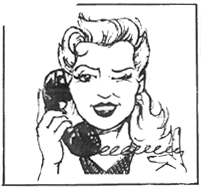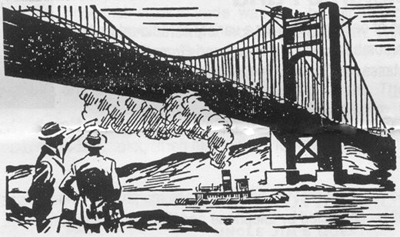|

This story was published in Radio Recall, the journal of the Metropolitan Washington Old-Time Radio Club, published six times per year.
Click here to return to the index of selected articles.
|
|
SAN FRANCISCO'S FINEST: "CANDY MATSON, YUkon 2-8209"
by Jack French, © 2002
(From Radio Recall, December 2002. This is part 2 of 2. Part 1 was in our October issue.)
Within a year of its debut, “Candy Matson, YUkon 2-8209” had accumulated a large and loyal audience. On June 19, 1950, Dwight Newton, the radio critic for The Examiner in San Francisco, came to the studio prior to the show and presented Monty and Natalie Masters with The Examiners’ Award for the “Favorite Local Radio Show.” His presentation, and their acceptance, was recorded as the beginning of the episode titled: “Symphony of Death.”
However, despite its popular acceptance, the series never found a sponsor, and it was a sustaining show for the entire time it was on the air. Obviously by 1950, dramatic radio was being reduced as advertising dollars gravitated toward the new medium of television. Radio personnel from San Francisco were lured to Los Angeles, where they sought work in movies and television.
 |
Candy Matson illustration
by Timothy Wallace
|
While Monty Masters did not use any of the NBC orchestra on “Candy Matson” (the sole musician was organist Eloise Rowan) the pranksters in the orchestra did not ignore him. One day, while Monty was otherwise engaged, they lifted his Volkswagen from its parking place, and carried it through the wide front doors of the Radio City building, and left it in the lobby . They topped it off with a “For Sale” sign and then they disappeared, to enjoy their mischief.
Despite the scrupulous accuracy that Monty employed in writing his scripts, including use of real names for all buildings, streets, and other locations, this did not apply to including all of the major groups in San Francisco’s population.
“San Francisco parents are advised to look closer to their daughters, for they know not the many dangers to which they are exposed.....and to counsel their sons, for when upon the streets of this gay city, they are wandering among many temptations...” -- B.E. Lloyd, historian (1876)
Of course, “gay city” did not mean the same thing in the 1800s, but by the end of WW II, San Francisco had the largest gay population of any city in the US. While network radio in the late 40s and early 50s would certainly not permit an openly gay character to appear on the air, Masters did manage to “suggest” that Rembrandt Watson was gay. Candy’s sidekick was single, middle-aged, fashion photographer who loved opera. If these clues were not enough, Jack Thomas added a slightly feminine flavor to his presentation. Whether many people in Candy’s large radio audience caught on is very unlikely. But, if he was gay, Watson was the only radio character that ever appeared on this series.
The other significant minority in San Francisco that received scarce, if any, exposure on “Candy Matson” was the Asian community. In 1950 the Bay City had more Chinese residents than any other city in the world, outside of Asia. One would think that therefore, Asian characters would appear often on a radio show based in San Francisco. But this was not the case. Not one Asian, identified by name or accent, appears in any role in the 14 surviving audio episodes of that series. (In addition to these, 81 scripts from the series are archived at Thousand Oaks Library in Los Angeles, CA but I haven’t had a chance to read them yet.)
...writing was superb, mixing taut excitement with generous humor...
But these omissions were but minor flaws in a series that had so many strengths. The writing was superb, mixing taut excitement with generous humor. Every episode included specific, and accurate, descriptions of Bay area geography. The sounds effects, by Bill Brownell and Jay Rendon, were true and timed perfectly, which advanced, but never interrupted, the plot. And the leads on the program were supported by a strong cast of players who boasted an unusual assortment of accents.
By the spring of 1951, the decision was made to terminate the series. Monty wrote the final episode, “Candy’s Last Case” which aired on May 21, 1951. This show , which had the independent Candy Matson, gushing like a soap opera ingenue over Mallard’s marriage proposal, was not a fitting climax to this otherwise remarkable series.
Many of the cast and crew re-located to Los Angeles, there to seek dwindling radio jobs or find occasional employment in television or film. Monty and Natalie did a little of both. She can be heard selling a Christmas tree to Fibber McGee and she was in a few TV westerns, some with her son, Tom. Jack Webb, who never forgot his San Francisco pals, put her in a few episodes of “Dragnet.”
Soundman Bill Brownell tried to make a living at NBC Hollywood, but there was too little work for too many soundmen. He left the industry to go into law enforcement with a sheriff’s department in a neighboring county. His buddy, Jay Rendon, stayed in San Francisco, left show-biz and spent the rest of his working life in the retail business. He is now retired in the Bay area.
Henry Leff had some success in the film industry, with good roles in “Take the Money and Run” and “One is a Lonely Number.” Lou Tobin, also the beneficiary of Jack Webb’s influence, got a role in his film, “The D.I.” [NOTE: Tobin spelled his first name, “Lu”, although it seldom appears that way in OTR sources.] Of all the cast members of the radio series, the most successful after moving to Hollywood, was Helen Kleeb. She got roles on one TV show after another, including “Golden Girls”, “Lou Grant Show”, “Bonanza”, “Get Smart”, “The Fugitive”, and “Dennis the Menace.”

The whereabouts of the radio program’s announcer, Dudley Manlove, is not known. His wife, Patty Pritchard, a pretty singer, used to portray “Jane” in a local, daily kid’s radio show, “Jolly Bill and Jane” in the 1950s. Her voice can still be heard today in San Francisco, on a local car dealer’s commercial.
Monty Masters died in 1969; possibly his alcohol consumption contributed to his early death at age 57. Natalie outlived him by seventeen years, passing away at age 70, in February 1986, survived by her son, Tom. Of the rest of their cast, not much is known, although Harold “Hal” Burdick died in June 1978, at the age of 84.
ADDENDUM
This series exists in audio form, fourteen different episodes in circulation, including the audition show, “Donna Durham Case”, and a reprise, which was done in Los Angeles in fall of 1952, “The Fortune Teller” (also referred to as “Allison Gray”.)
There is some difficulty in identifying the correct titles on the remaining dozen episodes since Monty Masters did not name any episodes. According to the staff at Thousand Oaks Library in CA, the 81 original scripts of this series, donated to their archives by the Masters’ estate, contain no identifying data other than broadcast date.
In the intervening years, OTR dealers have attached titles to each episode, although a few shows have come to be marketed under different names. The below represents the most accurate accounting of the dates (with the most common titles) of the episodes in common currency today.
Apr 4, 1949 (audition) “Donna Durham Case”
Jul 7, 1949 “Cable Car Murder”
Nov 7, 1949 “Devil In Deep Freeze”
Dec 19, 1949 “Missing Jack Frost”
Dec 26, 1949 “Valley of the Moon”
Jan 2, 1950 “NC 9-8012”
Feb 13, 1950 “Eric Spaulding Concert”
June 19, 1950 “Symphony of Death” (also called “Death in F-sharp”)
Sep 11, 1950 “Murder on the Movie Set” (also called “The Movie Company”)
Oct 9, 1950 “Fort Ord Story”
Oct 23, 1950 “Egyptian Amulet”
Dec 18, 1950 “San Juan Baptista Mission”
May 21, 1951 “Candy’s Last Case”
Sep 21, 1952 (reprise) “The Fortune Teller”
(also called “Allison Gray”)
REFERENCES
1) Barbara Watkins, in SPERDVAC “Radiogram”, March 1986, obituary of Natalie Masters
2) John F. Schneider, in SPERDVAC “Radiogram” March 1992, “San Francisco’s Network Radio”
3) Jay Hickerson’s “Necrology: OTR Personalities” 1996 and 1997 editions
4) Julian “Jay” Rendon, personal correspondence (May 2001 to present)
5) Encyclopedia Britanica, “History of California”
6) Jeanette Berard, Special Collections Staff, Thousand Oaks, CA Library System, personal correspondence, Sep 2002
7) Audio copies of all existing “Candy Matson” programs.
|